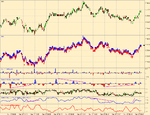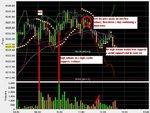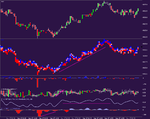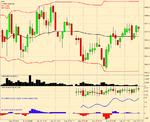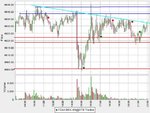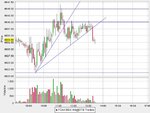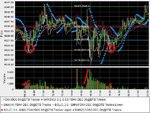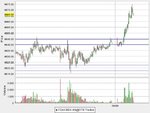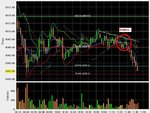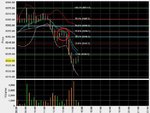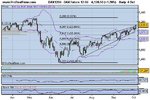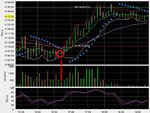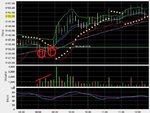It seems that most here are not scalpers, but others might still find the attached DAX chart interesting. It is an attempt to provide tape reading info without staring at the DOM all day.
Each bar is just 5 ticks (from IB data feed, so the 'ticks' may be aggregated first by Eurex, and secondly by IB).
From top to bottom we have:
1. Ordinary price candlestick
2. Market Delta type chart where each price level is coloured according to the difference of contracts traded at ask to contracts traded at bid. This type of plot is generally more usefull for substantially longer bars - say 100 ticks or more.
3. 'Histogram' type chart showing above ratio for the bar.
4. Smoothed version of 3.
5. The interesting bit. The ratio of total contacts at ask at all five levels of the order book to total contracts at bid plus total contracts at ask (all levels). It is shown as an OHLC series plotted as candlestick.
6. Smoothed version of 5.
7. ATR of 5 - an attempt to show volatility in the order book.
I'm sure I'm not giving the game away to point out a few things here. (Successfull scaplers MUST know this stuff already).
The implications of the volume at bid/ volume at ask are fairly obvious.
The order book behavior though, is at least on first sight, counter intuitive. As a general principle, the market moves towards size (until it doesn't). A micro trend down for example is often terminated by a rapid change in the order book where size moves to the ask. Continuation of a micro trend down is indicated by size staying on the bid (but not necessarily on best bid).
The second observation about the book is that book volatility frequently precedes change in micro trend and lack of volatility indicates continuation of micro trend.
The attached chart is not an especially good example, as DAX wandered about in a fairly aimless range after todays open, but I think the main points are still clear.
I have observered this book behavior on DAX, ESTX50, ES, ER2, SGXNK and K200. Of course each market is different due to liquidity and volatility and quite possibly other factors.
I'd be really interested to hear comments, especially from scalpers. And no, I don't think it's the holy grail - support and resistance including pivots, market profile levels, vwap, 'obvious' S/R levels and volume need to be closely observed.
Each bar is just 5 ticks (from IB data feed, so the 'ticks' may be aggregated first by Eurex, and secondly by IB).
From top to bottom we have:
1. Ordinary price candlestick
2. Market Delta type chart where each price level is coloured according to the difference of contracts traded at ask to contracts traded at bid. This type of plot is generally more usefull for substantially longer bars - say 100 ticks or more.
3. 'Histogram' type chart showing above ratio for the bar.
4. Smoothed version of 3.
5. The interesting bit. The ratio of total contacts at ask at all five levels of the order book to total contracts at bid plus total contracts at ask (all levels). It is shown as an OHLC series plotted as candlestick.
6. Smoothed version of 5.
7. ATR of 5 - an attempt to show volatility in the order book.
I'm sure I'm not giving the game away to point out a few things here. (Successfull scaplers MUST know this stuff already).
The implications of the volume at bid/ volume at ask are fairly obvious.
The order book behavior though, is at least on first sight, counter intuitive. As a general principle, the market moves towards size (until it doesn't). A micro trend down for example is often terminated by a rapid change in the order book where size moves to the ask. Continuation of a micro trend down is indicated by size staying on the bid (but not necessarily on best bid).
The second observation about the book is that book volatility frequently precedes change in micro trend and lack of volatility indicates continuation of micro trend.
The attached chart is not an especially good example, as DAX wandered about in a fairly aimless range after todays open, but I think the main points are still clear.
I have observered this book behavior on DAX, ESTX50, ES, ER2, SGXNK and K200. Of course each market is different due to liquidity and volatility and quite possibly other factors.
I'd be really interested to hear comments, especially from scalpers. And no, I don't think it's the holy grail - support and resistance including pivots, market profile levels, vwap, 'obvious' S/R levels and volume need to be closely observed.

